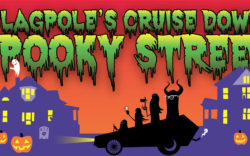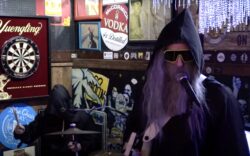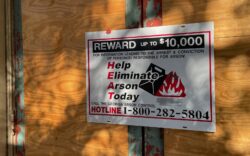Books
Argument of Hugh M. Dorsey at the Trial of Leo M. Frank (1914) This 146-page book, based on the trial transcript, contains the text of some, but not all, of the nine hours of closing arguments prosecutor Dorsey made on Aug. 22, 23, and 25, 1913.
Berry Benson, Five Arguments in the Leo Frank Case (1915) This short study, written by a Confederate Civil War veteran living in Augusta who specialized in deciphering codes, is the result of Benson’s scientific study of photographic enlargements of the murder notes. Benson concludes that the note written on the carbon copy order sheet was written first, and hurriedly. Benson also believes that some interval of time passed between the writing of the two notes, which conflicts with Conley’s testimony that the notes were written almost simultaneously. Finally, Benson concludes that the notes were composed by Jim Conley, not Leo Frank, which means that it was Conley who murdered Mary Phagan: “If Frank did not dictate the notes, then Conley was the murderer.”
Ward Greene, Death in the Deep South (1936) The first novel about the Leo Frank case.
Charles and Louise Samuels, Night Fell on Georgia (1956) In this careful study, the best nonfiction book-length account of the Leo Frank case published before 1965, the authors describe the case as a “classic example of injustice in our twentieth century courts.” The authors conclude that “Leo Frank was the victim of the one of the most shocking frame-ups ever perpetrated by American law-and-order officials,” and that Frank’s case is “one of the most celebrated modern criminal cases in which frame-ups were obviously perpetrated.” The authors also remind us that the case of Leo Frank “is the only celebrated American murder case of the twentieth century in which religious prejudice played a predominant role.”
Harry Golden, A Little Girl Is Dead (1965) This excellent account of the Leo Frank case by a North Carolina newspaper editor is one of only a handful of books containing the complete text of Gov. Slaton’s June 21, 1915 order commuting Frank’s sentence.
Richard Kluger, Members of the Tribe (1977) A novel based on the Leo Frank case.
Leonard Dinnerstein, The Leo Frank Case (1968; reprinted 1987, 1999) A modified version of the author’s Ph.D. dissertation, this superb book was and remains the best scholarly account of the Leo Frank case. The author is a history professor at the University of Arizona. The author summarizes the Leo Frank case as “one of the causes celebres of the [twentieth] century,” “one of the most infamous outbursts of anti-Semitic feeling in the United States,” “one of the most talked-about injustices of the Progressive Era,” and “one of the most lurid displays of intolerance in the Progressive Era.”
Julie Ellis, The Hampton Women (1980) A novel based on the Leo Frank case.
Mary Phagan, The Murder of Little Mary Phagan (1987) This intriguing book is invaluable because it quotes extensively from many important documents relevant to the Leo Frank case. For example, it includes the full text of Gov. Slaton’s commutation order and Alonzo Mann’s Mar. 4, 1982 affidavit, and it furnishes lengthy excerpts from Jim Conley’s direct examination testimony and Leo Frank’s unsworn statement at the trial. The author is the great niece and a namesake of the little girl whose murder triggered the Leo Frank case. The author seems to doubt that Frank received an unfair trial and appears to almost sympathize with his lynchers, but does acknowledge having some doubt about whether Frank was the murderer. Astonishingly, the author reveals that in 1934 members of the family of the murdered girl – convinced of Frank’s guilt and reposing infinite faith in prosecutor Hugh Dorsey – invited Jim Conley into their home and received him as an honored guest, and even gave him money!
Robert Seitz Frey and Nancy Thompson-Frey, The Silent and the Damned: The Murder of Mary Phagan and the Lynching of Leo Frank (1988) This admirable account of the Leo Frank case features nearly 40 helpful illustrations. Leo Frank’s trial, the authors assert, took place “in an atmosphere of hostility and violence,” and his conviction was a “hideous stain on our legal system.”
David Mamet, The Old Religion (1997) A novel based on the Leo Frank case. The author is a Pulitzer Prize-winning playwright.
Jeffrey Melnick, Black-Jewish Relations on Trial: Leo Frank and Jim Conley in the New South (2000) This book, by a history professor, examines the stereotypes about both Jews and African Americans which underlay public perceptions of the Leo Frank case as it unfolded, and which continue to permeate modern historical writings about the case. The attorneys for both the prosecution and the defense, Melnick emphasizes, relied on racist assumptions, particularly in dealing with Jim Conley’s testimony.
Steve Oney, And the Dead Shall Rise: The Murder of Mary Phagan and the Lynching of Leo Frank (2003) This book, the result of 17 years of research and investigation, is the definitive work on the Leo Frank case.
Book Chapters
C. Vann Woodward: Tom Watson: Agrarian Rebel (1938; 2nd ed. 1973). Chapter 22, “The Lecherous Jew,” explores Watson’s loathsome journalistic crusade against Leo Frank.
Arthur G. Powell, I Can Go Home Again (1943; reprinted 1984). In Chapter 36, entitled “Up Against the Mob,” Powell, a distinguished Georgia jurist and attorney, writes: “I am one of the few people who know that Leo Frank was innocent of the crime for which he was convicted and lynched. Subsequent to the trial, and after his conviction had been affirmed by the [Georgia] Supreme Court, I learned who killed Mary Phagan, but the information came to me in such a way that, though I wish to do so, I can never reveal it so long as certain persons are alive… Without having discussed with Governor Slaton the facts which were revealed to me, I have reason to believe, from a thing contained in the statement he made in connection with the grant of the commutation, that, in some way, these facts came to him and influenced his action.” It is now known, based on Allen Lumpkin Henson’s book (discussed below), that Powell knew of Frank’s innocence because he had been told by Judge Roan, Frank’s trial judge, of a visit to Roan by Jim Conley’s lawyer, William M. Smith, who told Roan that Conley had murdered Mary Phagan. Powell’s belief that before the commutation Slaton had been apprised of Smith’s knowledge of Conley’s guilt has since been confirmed by other sources.
Francis X. Busch, Guilty or Not Guilty? (1952) Chapter 1, “The Trial of Leo Frank for the Murder of Mary Phagan (1913),” is 63 pages long. The author concludes: “[F]rank may have been guilty, and he may have been innocent. One simply cannot, with evidence supporting reason, declare unequivocally that he was guilty or that he was not guilty. There is evidence and reasonable probability to support either conclusion… Nevertheless, from the present perspective a conscientious reader of the record puts it down with the uncertain and troubled feeling that Frank’s guilt was not proved beyond a reasonable doubt and that he may have been the victim of one of the most flagrant miscarriages of justice recorded in American criminal annals.”
Allen Lumpkin Henson, Confessions of a Criminal Lawyer (1959). In Chapter 7, entitled “The Leo M. Frank Case,” Henson, a distinguished Atlanta attorney who had served as an assistant state attorney general during Gov. John M. Slaton’s term of office, explains how Arthur G. Powell knew that Frank was innocent. According to Henson, soon after Frank’s conviction Judge Roan received a visit from William M. Smith, Jim Conley’s lawyer, who told Roan that Conley had admitted having murdered Mary Phagan to Smith. (It is now known that Conley never actually admitted killing Phagan to Smith; Smith’s knowledge of Conley’s guilt was based on Smith’s own investigation. Henson was therefore wrong in asserting that Conley had confessed to Smith and that Smith had spoken of such a confession, although undoubtedly Smith did tell Roan of his belief that Conley was the murderer.) Henson also reveals that Judge Roan passed on Smith’s disclosures about Conley’s guilt to two other distinguished Georgia jurists, Arthur Powell (who served on the Georgia Court of Appeals from 1907 to 1912) and Frederick C. Foster (a superior court judge in Morgan County for many years).
Pierre Van Paassen, To Number Our Days (1964). This book is an autobiography written by a noted Dutch journalist. In Chapter 6, “Short Stand in Dixieland,” Van Paassen reveals that in 1922, while briefly serving as a reporter for The Atlanta Constitution, he conducted his own investigation of the Leo Frank case, reading the documents and evidence at the courthouse. He found that Mary Phagan “had been bitten on the left shoulder and neck before being strangled,” and that “photos of the teeth marks on her body did not correspond with Leo Frank’s set of teeth of which several photos were included.” He was, however, denied permission to write any articles about the Frank case.
Frederic Cople Jaher (ed.), The Age of Industrialism in America (1968). Chapter 12, entitled “Atlanta in the Progressive Era: A Dreyfus Affair in Georgia,” is authored by Leonard Dinnerstein and examines the Leo Frank case in light of early 20th Century industrial development in the American South.
Steven Hertzberg, Strangers Within the Gate City: The Jews of Atlanta, 1845-1915 (1978). Chapter 9, “The Leo Frank Case,” examines the Frank case (which the author notes “was far more than a judicial proceeding”) in depth and describes the case as “perhaps the most lurid manifestation of anti-Semitism in American history.”
Articles
Clement Charlton Moseley, “The Case of Leo M. Frank,” 51 Ga. Hist. Q. 42 (1967) Although dated and marred by a few factual errors, this article by a distinguished history professor remains the best single short account of the Frank case ever published in a scholarly journal. “The lynching of Leo Frank,” Moseley concludes, “was the consummation of a vast modern tragedy. The most tragic figure was not the murdered Jew but the figure of justice and the shame of a State… The entire inglorious episode of the crime against the Jew… may be summed up in three words – politics, prejudice, and perjury.”
Eugene Levy, “‘Is the Jew a White Man?’ Press Reaction to the Leo Frank Case, 1913-1915,” 35 Phylon 212 (1974) This article by a history professor examines editorials about the Leo Frank case which appeared in the Jewish press or in African-American newspapers. According to Levy, many Jewish newspapers looked at the case as simply another chapter in this history of anti-Semitism, with some depicting Jim Conley as a “black brute” or “depraved Negro.” On the other hand, many African-American editors, Levy asserts, tended to sympathize with Jim Conley, warning that “whites were again looking for a black scapegoat.”
Steve Oney, “The Lynching of Leo Frank,” 104 Esquire 90 (Sept. 1985) An earlier account of Frank’s murder, written by the author of And the Dead Shall Rise.
Nancy MacLean, “The Leo Frank Case Reconsidered: Gender and Sexual Politics in the Making of Reactionary Populism,” 78 J. Am. Hist. 917 (1991) This scholarly article by a history professor examines the Leo Frank case insofar as it was “a spectacular instance of a pattern of political mobilization best described as reactionary populism” – the anti-elitism that is characteristic of populism and that sometimes “garners mass support for a political agenda that enforces the subordination of whole groups of people.”
Leonard Dinnerstein, “The Fate of Leo Frank,” 47 American Heritage 99 (Oct. 1996) This article by Prof. Dinnerstein is the finest short article on the Leo Frank case ever published.
Stephen J. Goldfarb, “Framed,” 47 American Heritage 109 (Oct. 1996) This article, by an Atlanta librarian, shows that there was a secret conspiracy between prosecutor Hugh Dorsey and Pinkerton’s detective Harry Scott (second in command of Pinkerton’s Atlanta branch office) to convict Leo Frank, even though the Pinkerton detective agency had been hired by Frank’s employer to assist Frank in his defense and was supposed to be on Frank’s side. The article also proves “the malign role played by the prosecutor, Hugh Dorsey,” by adducing evidence which “strongly suggests that Dorsey urged witnesses to embellish their testimony, even lie under oath, to build a case against Frank.”
Steve Oney, “And the Dead Shall Rise,” 83 Georgia Magazine 38 (Mar. 2004) In this little article Oney discusses aspects of his 17-year project researching and writing about the murder of Mary Phagan, the criminal proceedings against Leo Frank, and Frank’s infamous lynching. The Leo Frank case is, he says, “one of the most complex and incendiary episodes in Georgia’s past and the nation’s.” He also “declare[s] [his] belief in Frank’s innocence and the state’s culpability in his lynching.”
Like what you just read? Support Flagpole by making a donation today. Every dollar you give helps fund our ongoing mission to provide Athens with quality, independent journalism.











